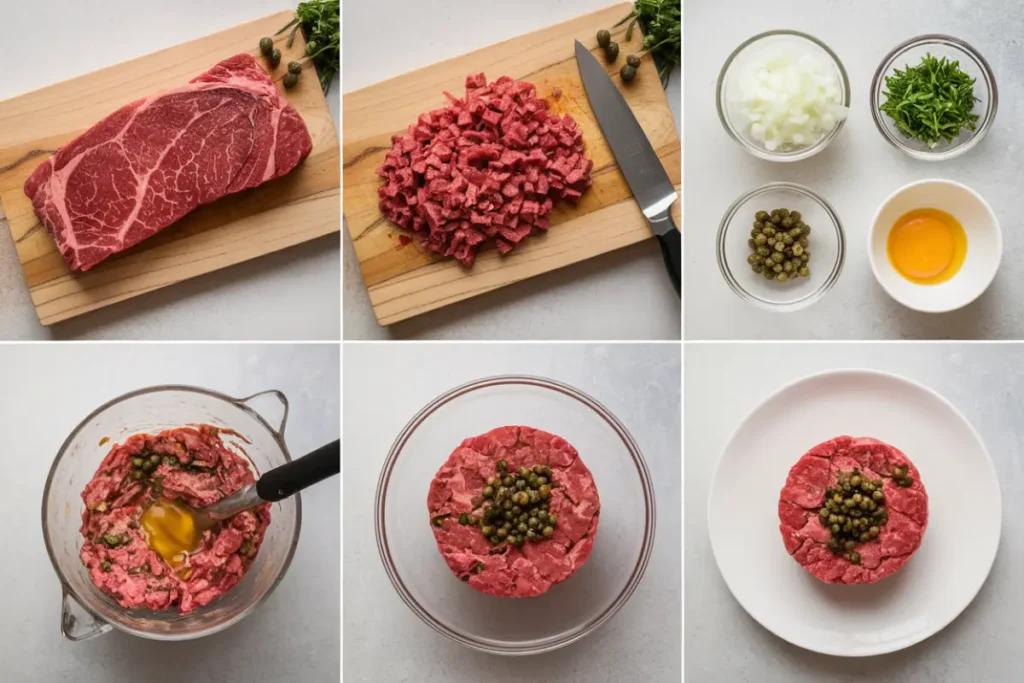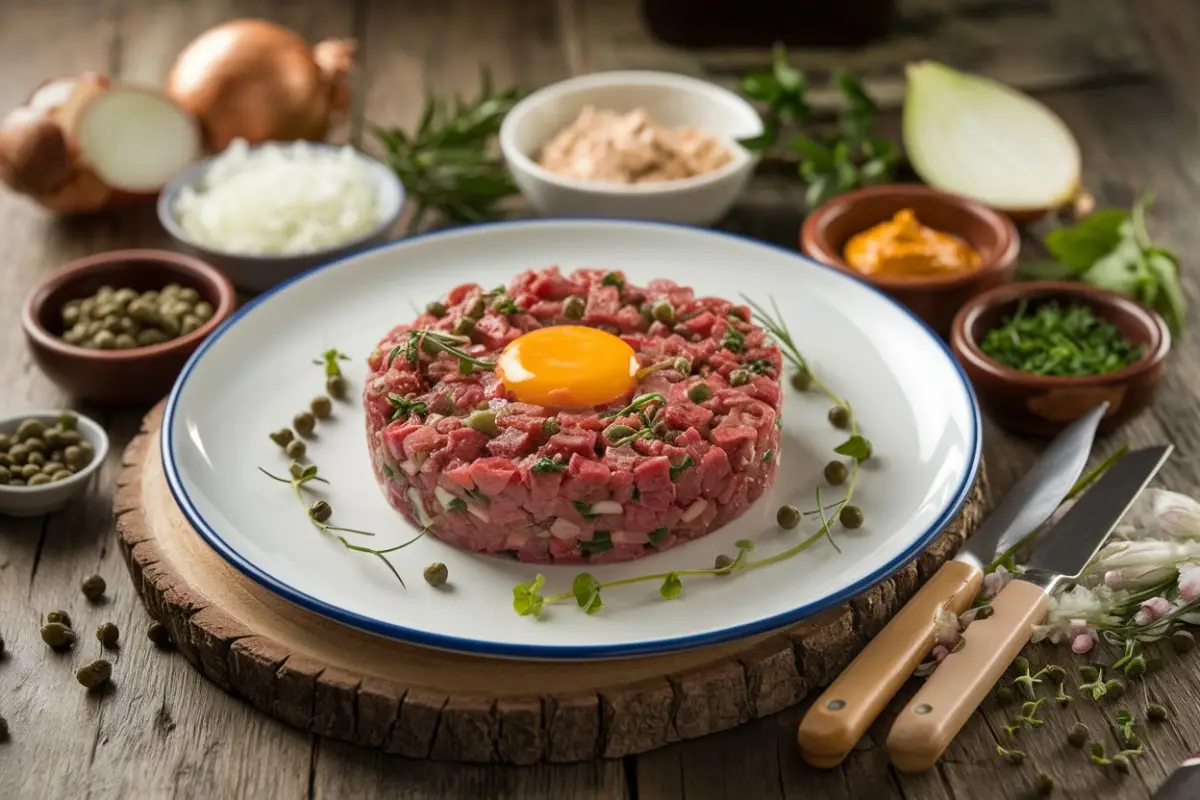Steak tartare is a culinary delicacy that captivates food enthusiasts worldwide. This dish, featuring raw, finely chopped beef, is as much about art as it is about flavor. If you’re curious about what are the rules for steak tartare and how to make it at home or enjoy it in a restaurant, you’ve come to the right place. In this guide, we’ll break down every detail you need to know, from essential ingredients to presentation tips.
Introduction to Steak Tartare
Steak tartare is a classic dish rooted in French cuisine. It consists of finely chopped or minced raw beef, seasoned and mixed with various ingredients such as onions, capers, and seasonings, typically topped with an egg yolk. The dish boasts rich flavors and a luxurious texture, making it a favorite in fine dining and among food lovers.
- Keyphrase: What are the rules for steak tartare is a common question among those new to the dish, combining the precision of preparation with the need for high-quality ingredients.
The Basics: What Makes a Good Steak Tartare?
Understanding what are the rules for steak tartare starts with recognizing the key elements of a great dish. Here are the fundamentals:
- Quality of Beef: The beef itself is the cornerstone of steak tartare. Only the freshest and highest-quality cuts, such as beef tenderloin or filet mignon, should be used. Learn more about what kind of meat is used for beef tartare to ensure the best results.
- Knife Skills: Unlike ground beef, steak tartare requires finely chopped meat. This technique ensures a pleasing texture while maintaining the beef’s flavor.
- Fresh Ingredients: Ingredients like onions, capers, and seasonings must be fresh and finely chopped to blend seamlessly into the dish.
- Seasoning: Steak tartare needs to be well-seasoned with salt, pepper, mustard, and other spices. The seasoning should enhance the taste of the raw beef, not overpower it.
Health and Safety Rules for Preparing Steak Tartare
When preparing steak tartare, food safety is critical. Since the dish involves raw beef, strict guidelines must be followed:
- Use Fresh, High-Quality Meat: Purchase the beef fresh from a trusted source. Avoid previously frozen meat, as it can compromise both texture and safety.
- Sanitize Equipment: Thoroughly sanitize all knives, cutting boards, and utensils before and after use to prevent cross-contamination.
- Proper Handling of Raw Meat: Keep the beef cold until it’s time to prepare the dish. This practice reduces the risk of bacterial growth, which is crucial when serving raw meat.
- Health Risks: Consuming raw meat carries certain risks, such as exposure to bacteria like E. coli and Salmonella. Knowing what are the rules for steak tartare involves understanding these risks and taking steps to mitigate them.
The Art of Balancing Flavors in Steak Tartare
Creating the perfect steak tartare requires a delicate balance of flavors. Here’s how to achieve it:
- Seasoning: Use salt and pepper generously but not excessively. Mustard, usually Dijon, adds a sharpness that complements the richness of the beef.
- Acidity: A splash of lemon juice or a dash of vinegar brightens the dish, cutting through the beef’s fattiness.
- Spice: A hint of spice, often from Tabasco or a similar sauce, adds complexity to the dish. However, it’s important not to overdo it—steak tartare should have a gentle heat, not an overwhelming burn.
- Condiments and Add-ins: Ingredients like capers, shallots, and herbs add texture and enhance the overall flavor profile.

Variations of Steak Tartare
While the classic French version is perhaps the most well-known, steak tartare offers several variations:
- Classic French Style: This version typically includes Dijon mustard, capers, onions, and egg yolk, mixed into finely chopped beef. The flavors remain subtle yet sophisticated, focusing on the quality of the meat.
- Regional Variations:
- Belgian Steak Tartare: Known as “filet américain,” this version offers a creamier texture and is often served with fries.
- Italian Version: Olive oil, Parmesan cheese, and truffles bring a luxurious twist to this variation.
- Modern Twists and Fusion Versions: Some chefs introduce unique ingredients like avocado, Asian spices, or even create vegetarian versions using beetroot or other vegetables.
The Role of Texture in Steak Tartare
Texture plays a crucial role in a great steak tartare:
- Knife Skills: Finely chopping the beef ensures a consistent texture that melts in your mouth. Coarse or unevenly chopped meat detracts from the dish.
- Add-ins: Ingredients like onions, capers, and herbs should be finely chopped to match the texture of the beef. Larger pieces can disrupt the dish’s balance.
- Consistency: The beef should be tender, not chewy, with a smooth yet slightly coarse texture that holds the seasonings well.
Serving Steak Tartare: Etiquette and Presentation
How you serve steak tartare can elevate the dining experience:
- Traditional Presentation: Typically, steak tartare is served with the beef mixture formed into a neat mound on the plate, often topped with a raw egg yolk. It may be accompanied by toast points or thin slices of baguette.
- Modern Presentation Techniques: Some chefs deconstruct the dish, presenting the ingredients separately for the diner to mix, or use molds to create visually striking shapes.
- Pairing: Steak tartare pairs well with crisp, fresh greens and a side of crispy fries. Consider serving it with pickles or Pickle de Gallo, a tangy twist on salsa, for an extra burst of flavor.
Rules for Ordering and Eating Steak Tartare in Restaurants
When dining out, understanding what are the rules for steak tartare enhances the experience:
- How to Order: When ordering steak tartare, inquire about the cut of meat used and how it’s prepared. A reputable restaurant will use high-quality beef and prepare it fresh.
- Expectations: Expect a dish that is fresh, well-seasoned, and beautifully presented. The beef should be tender and flavorful, with the accompaniments enhancing the overall dish.
- Etiquette: When eating steak tartare, mix the egg yolk into the beef mixture if it hasn’t already been done. Take small bites and savor the flavor and texture.
FAQs and Common Concerns
Is Steak Tartare Safe to Eat?
Yes, when prepared correctly with fresh, high-quality meat and proper handling, steak tartare is safe to eat. Following food safety and preparation guidelines is key.
What Should You Avoid in Steak Tartare?
Avoid using frozen or low-quality meat, as it affects both the flavor and safety of the dish. Also, steer clear of over-seasoning; the goal is to enhance the beef’s natural flavor.
Can You Customize Steak Tartare?
Absolutely! While traditional recipes are popular, you can customize steak tartare to your taste by adjusting the seasonings, adding unique ingredients, or experimenting with different cuts of beef.
Conclusion and Final Thoughts
Understanding what are the rules for steak tartare involves more than just knowing the ingredients. It’s about appreciating the delicate balance of flavors, the importance of fresh, high-quality meat, and the art of preparation. Whether you’re making steak tartare at home or enjoying it in a restaurant, these guidelines will help you appreciate this classic dish at its best.
And if you’re interested in other classic dishes or culinary techniques, explore our ultimate guide to pumpkin bars or try out this delicious beefaroni recipe.
FAQs
1. How do you ensure safety when preparing steak tartare?
- Use the freshest meat from a reliable source, keep it cold until preparation, sanitize all utensils and work surfaces, and consume the dish immediately after preparation.
2. Can steak tartare be made with different cuts of beef?
- Yes, while tenderloin is most commonly used, other cuts like sirloin or filet mignon work as long as they are fresh and of high quality.
3. What are some common accompaniments for steak tartare?
- Steak tartare is often served with toast, fries, or a simple green salad. Pickles, capers, and tartare sauce are also popular accompaniments.
4. How should steak tartare be stored if not eaten immediately?
- It’s best to prepare and eat steak tartare fresh. However, if you must store it, cover it tightly and refrigerate it for no more than a couple of hours.
5. What is the best seasoning for steak tartare?
- The best seasoning includes salt, pepper, Dijon mustard, and a touch of acidity from lemon juice or vinegar. Fresh herbs like parsley or chives can also enhance the flavor.
Classic Steak Tartare
- Total Time: 15 minutes
- Yield: 2 servings 1x
- Diet: Paleo
Description
Steak tartare is a classic dish featuring finely chopped raw beef, seasoned and garnished with a variety of fresh ingredients, perfect for culinary enthusiasts.
Ingredients
- 8 oz beef tenderloin, finely chopped
- 1 small shallot, finely chopped
- 2 tbsp capers, finely chopped
- 1 tbsp Dijon mustard
- 1 egg yolk
- 1 tbsp olive oil
- Salt and pepper to taste
- 1 tsp lemon juice
Instructions
- Use a sharp knife to finely chop the beef tenderloin until it reaches a consistent texture.
- In a mixing bowl, combine the chopped beef with shallot, capers, olive oil, mustard, salt, pepper, and lemon juice.
- Taste and adjust seasoning as necessary.
- Form the mixture into a mound on a serving plate and create a small well in the center.
- Top with the raw egg yolk and serve immediately with toast points or baguette slices.
Notes
Ensure to use the freshest quality beef and sanitize all utensils properly.
- Prep Time: 15 minutes
- Cook Time: 0 minutes
- Category: Appetizer
- Method: No-cook
- Cuisine: French
Nutrition
- Serving Size: 1 serving
- Calories: 250
- Sugar: 0g
- Sodium: 500mg
- Fat: 18g
- Saturated Fat: 5g
- Unsaturated Fat: 12g
- Trans Fat: 0g
- Carbohydrates: 1g
- Fiber: 0g
- Protein: 20g
- Cholesterol: 186mg
Keywords: steak tartare, raw beef, French cuisine, gourmet appetizer, culinary classic

